List of Contents
North America Diabetic Foot Ulcer Treatment Market Size and Forecast 2025 to 2034
The North America diabetic foot ulcer treatment market size is projected to be worth around USD 5.56 billion by 2034 from USD 3.15 billion in 2024, at a CAGR of 5.99% from 2025 to 2034. The rising cases of diabetes, and advanced research and development drive the North America diabetic foot ulcer treatment market. Alongside, the well-established healthcare infrastructure is observed to promote the market's expansion in the upcoming years.
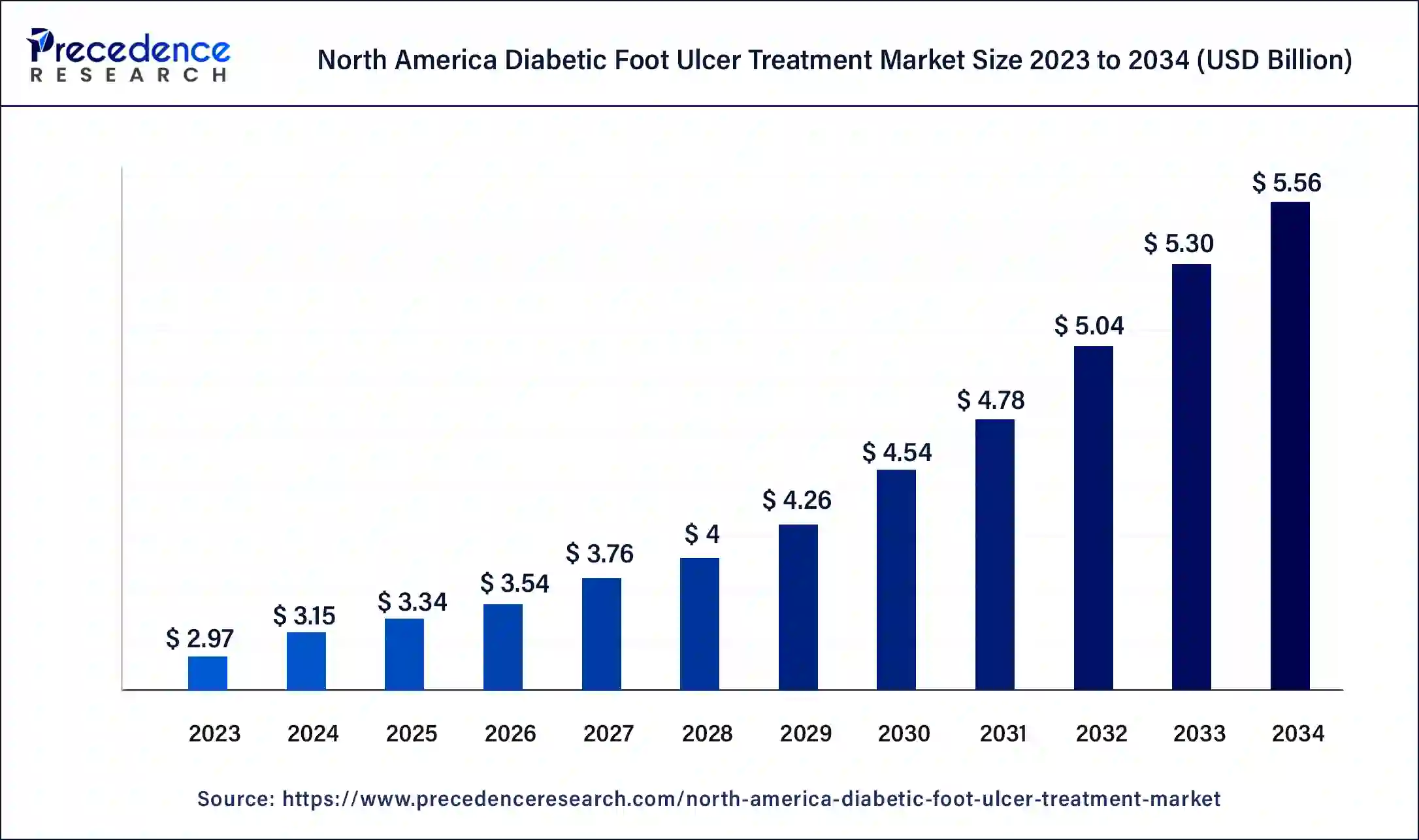
North America Diabetic Foot Ulcer Treatment Market Key Takeaways
- The North America diabetic foot ulcer treatment market was valued at USD 3.15 billion in 2024.
- It is projected to reach USD 5.56 billion by 2034.
- The North America diabetic foot ulcer treatment market is expected to grow at a CAGR of 5.99% from 2025 to 2034.
- The United States dominated the market with the largest market share of 78% in 2024.
- Canada is estimated to grow fastest during the forecast period.
- By ulcer type, the neuro-ischemic ulcers segment contributed more than 44% of market share in 2024.
- By ulcer type, the neuropathic ulcers segment is estimated to grow fastest during the forecast period.
- By treatment, the wound dressing segment generated the biggest market share of 43% in 2024.
- By treatment, the wound care devices segment is anticipated to grow significantly during the forecast period.
- By end-user, the hospitals segment accounted for the major market share of 42% in 2024.
- By end-user, the ambulatory surgical centers segment is expected to grow fastest during the forecast period.
U.S. Diabetic Foot Ulcer Treatment Market Size and Growth 2025 to 2034
The U.S. North America diabetic foot ulcer treatment market size was exhibited at USD 3.45 billion in 2024 and is projected to be worth around USD 6.22 billion by 2034, poised to grow at a CAGR of 6.07% from 2025 to 2034.
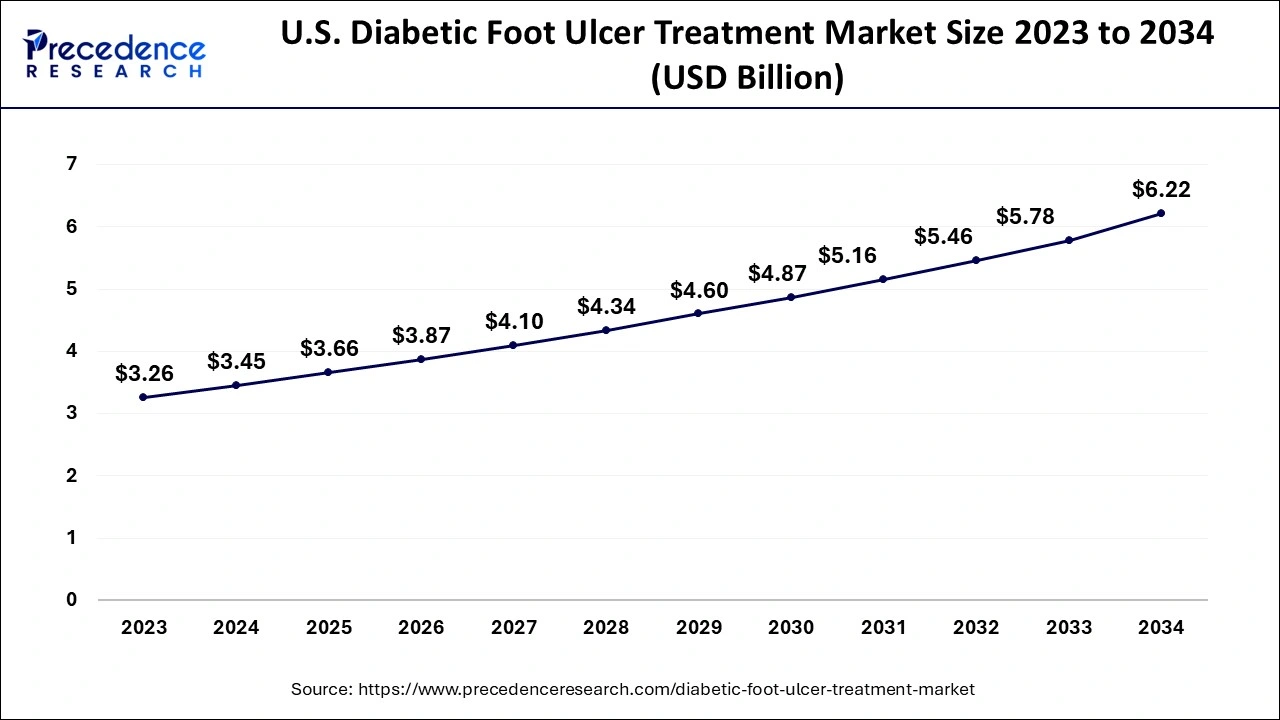
The globaldiabetic foot ulcer treatment market size reached USD 9.13 billion in 2024 and is expected to attain around USD 16.19 billion by 2034, poised to grow at a CAGR of 5.90% between 2025 and 2034.
The U.S. dominated the North America diabetic foot ulcer treatment market in 2023. The rising prevalence of diabetes is a major concern for the increasing cases of DFU. Approximately 18.6 million people worldwide are diagnosed with DFU every year, with 1.6 million in the US itself. The growing research and development and the state-of-the-art healthcare facilities boost the market growth in the region. The government initiatives on combating diabetes and reimbursement policies also augment the market growth.
- In June 2024, Discovery Therapeutics Caribe, a US-based biotech company received USFDA approval to run a clinical trial in America for Heberprot-P, a drug to heal DFU developed by Cuba two decades ago.
Canada is anticipated to grow the fastest during the forecast period in the North America diabetic foot ulcer treatment market. The rising prevalence of diabetes, growing research and development, state-of-the-art healthcare facilities, increasing awareness, increased collaborations, government initiatives, and investments drive the market growth. Ontario offers full coverage for off-loading devices in the Canadian province.
- In August 2022, Health PEI, publically funded health services, made locally available an innovative Canadian technology to identify challenges in a person's walking or balance function. The foot pressure mapping function measures and identifies peak pressure points for the development of DFU. This technology enabled early intervention and prevention of DFU.
Market Overview
Diabetic foot ulcer (DFU) is a wound affecting the big toes and the balls of the feet, caused due to neuropathic and/or vascular complications in diabetic patients. These ulcers are formed due to the breaking down of skin tissue and exposing the layers underneath. DFU can be caused by anyone suffering from diabetes. About one-third of people with diabetes develop DFU once in their lifetime. DFU can be treated by wearing special shoes designed for diabetics or a brace, specialized castings, or using a wheelchair or crutches. DFU patients can be treated by applying dressings, removing dead skin or foreign objects causing foot ulcers, also known as debridement, or by physical exercises. Patients are prescribed antibiotics, antiplatelet, and anticlotting medications if the infection persists.
Major Breakthroughs Made for Ulcer Treatments
- In March 2023, Microbion Corporation announced the initiation of Phase 2 randomized controlled study to evaluate topical Pravibismane (MBN-101) for the treatment of diabetic foot infections. The trials were conducted at select wound care centers in Texas and California to assess the safety and tolerability of the drug.
- In June 2024, StimLabs announced the Institutional Review Board (IRB) authorization to begin the CAMPSTIM clinical trial for placental-based tissue allograft products in treating patients with hard-to-heal DFUs.
- In August 2024, BioStem Technologies announced the receipt of Institutional Review Board (IRB) approval for conducting a clinical trial to evaluate Vendaje against standard care for non-healing DFUs. Vendaje is a placental-derived allograft using BioStem's proprietary BioREtain technology.
What is the role of AI in Ulcer Treatment?
The development of AI and ML technologies promotes diabetic foot ulcer treatment through improved precision and customized treatment plans. These advanced technologies facilitate the early detection of DFUs by leveraging biomarkers and promoting timely intervention. In addition, AI can also predict the healing trajectory of DFU, assess the high risk of the disease, and suggest personalized treatment options.
Also, the emergence of smartphones and smart tools simplifies the measurement process such as wound surface area and duration, thereby facilitating effective treatment. This encourages the use of telemedicine, especially for the rural population. Furthermore, AI can also assist healthcare professionals in surgeries by using robots. Therefore, enabling early detection and personalized treatment strategies by AI improves patient outcomes. AI also helps optimize healthcare resources by lowering the clinical burden and the incidence of serious consequences related to diabetic foot ulcers.
- In October 2023, Spectral AI Inc., a Dallas-based predictive AI company focused on medical diagnostics, expanded its diabetic foot ulcer study to seven clinical sites. The company's DeepView Wound Imaging System is an AI technology providing healing assessment of DFUs for accurate and timely diagnosis and therapeutic intervention.
Market Scope
| Report Coverage | Details |
| North America Market Size by 2034 | USD 5.56 Billion |
| North America Market Size in 2025 | USD 5.22 Billion |
| North America Market Size in 2024 | USD 3.15 Billion |
| Market Growth Rate from 2025 to 2034 | CAGR of 5.99% |
| Base Year | 2024 |
| Forecast Period | 2025 to 2034 |
| Segments Covered | Ulcer Type, Treatment, and End-user |
Market Dynamics
Driver
Increasing diabetes prevalence
The increasing prevalence of diabetes mellitus (type 1 and 2) leads to serious complications like heart disease, stroke, blindness, kidney failure, diabetic neuropathy, etc. Such severe factors are observe to act as a driver for the North America diabetic foot ulcer treatment market. Patients living with more than 10 years of diabetes have a high chance of developing DFU in their lifetime.
It has been reported that around 537 million people globally suffer from diabetes, out of which 19% to 34% develop DFU in their lifetime. Of these, approximately 20% of DFU patients are estimated to require lower-extremity amputation and 10% will die within 1 year of diagnosis. Hence, effective treatment of diabetic foot ulcers in North America is essential. Additionally, the diabetes-related health expenditure in the US was estimated to be around $412.9 billion in 2022, whereas that in Canada was estimated to be around $14.3 billion in 2021.
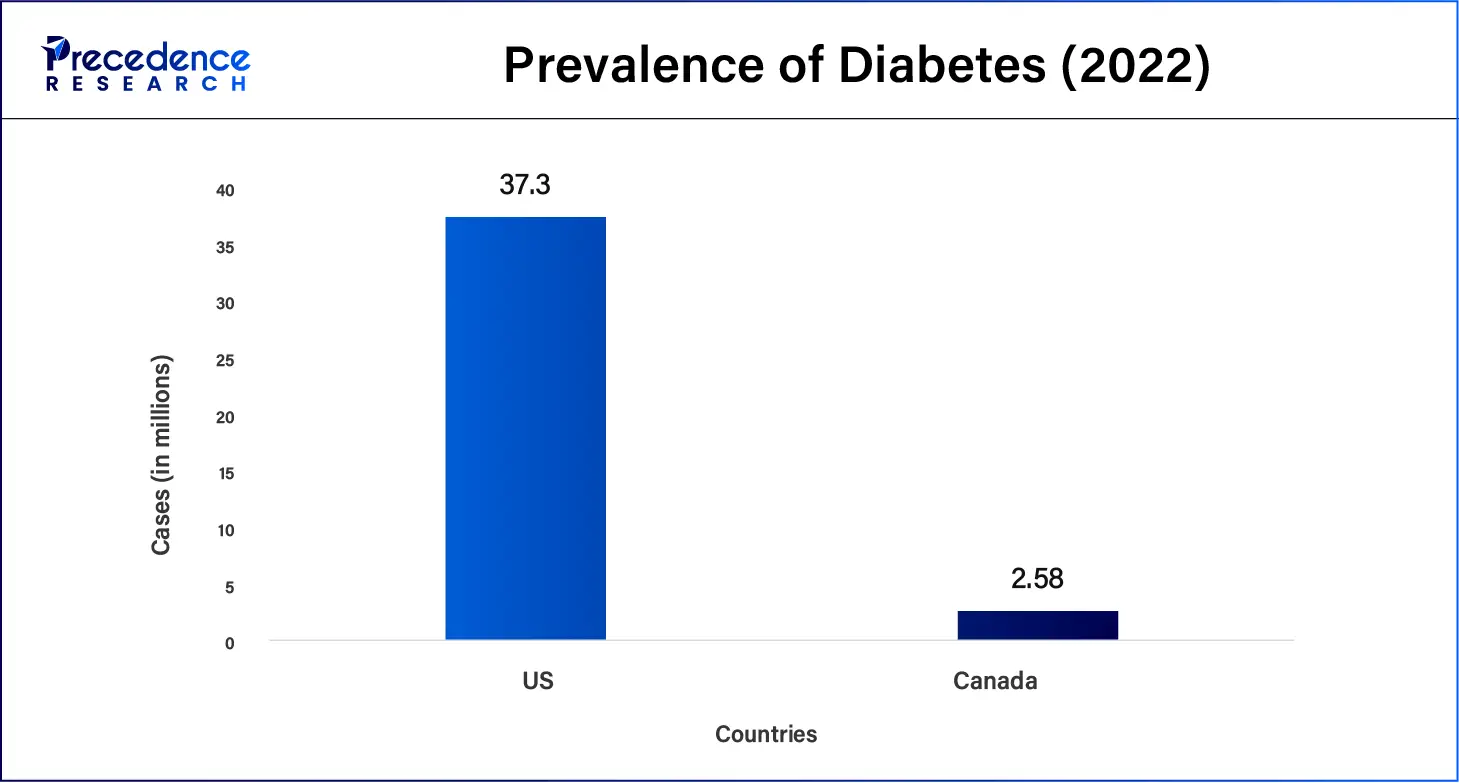
Restraint
High Treatment Cost
Diabetic foot ulcers are one of the most severe complications of diabetes, resulting in reduced quality of life and financial burden on individuals. The high treatment costs of DFUs limit the affordability of patients. Lack of awareness among individuals combat the early diagnosis and lower screening rates, thereby limiting the treatment for DFU patients. The limited treatment regimens and high recurrence rates result in low patient adherence. All these aspects along with limited adoption in underdeveloped areas are observed to hinder the growth of North America diabetic foot ulcer treatment market.
Opportunity
Integration of Cell and Gene Therapy
The conventional treatment regimen fails to provide complete relief from the DFUs. Hence, several researchers are investigating the effect of cell and gene therapy for therapeutic intervention. Cell and gene therapy have provided promising results in patients, promoting its widespread use. This regenerative medicine promotes angiogenesis, cell proliferation, and collagen deposition, and ameliorates neuro-ischemia and inflammation. With the technological advancements, such integration is observed to offer sustainable opportunities to the North America diabetic foot ulcer treatment market.
It has been found that growth factors are actively involved in DFU pathogenesis, hence targeting them can prove to be an effective strategy. Cell and gene therapy enhances the delivery efficiency of growth factors. At present, there are around 36 clinical trials, assessing the role of cell and gene therapy in treating DFUs. Hence, cell and gene therapy has a huge potential in the future for the effective treatment of DFU.
- In January 2024, RION, a clinical-stage regenerative medicine company successfully conducted a Phase 2A study for Purified Exosome Product (PEP) in diabetic foot ulcers. The clinical trial focussed on evaluating the safety and efficacy of PEP with TISSEEL fibrin sealant for treating DFU.
Ulcer Type Insights
The neuro-ischemic ulcers segment dominated North America diabetic foot ulcer treatment market in 2024. Neuro-ischemic ulcers are a combination of peripheral neuropathy and ischemia, i.e., loss of neuronal sensations and blood flow, respectively. It is estimated that around 15-20% of diabetic patients develop peripheral artery disease after 10 years of diagnosis, and nearly 45% of diabetic patients develop peripheral artery disease after 20 years. The emergence of neuro-ischemic ulcers is increasing gradually among diabetic patients. They develop on toe tips and beneath overly thick toenails. However, they possess a high risk as they are incurable, infectious, and lead to amputation, and death. Hence, the increasing cases of neuro-ischemic ulcers, their severity, and growing research and development augment the market growth.
- In May 2023, the US researchers conducted a randomized, placebo-controlled phase 3 study of VM202 (ENGENSIS), a plasmid DNA encoding human hepatocyte growth factor, in DFU patients. VM202 showed promising results in patients with chronic neuro-ischemic DFU patients.
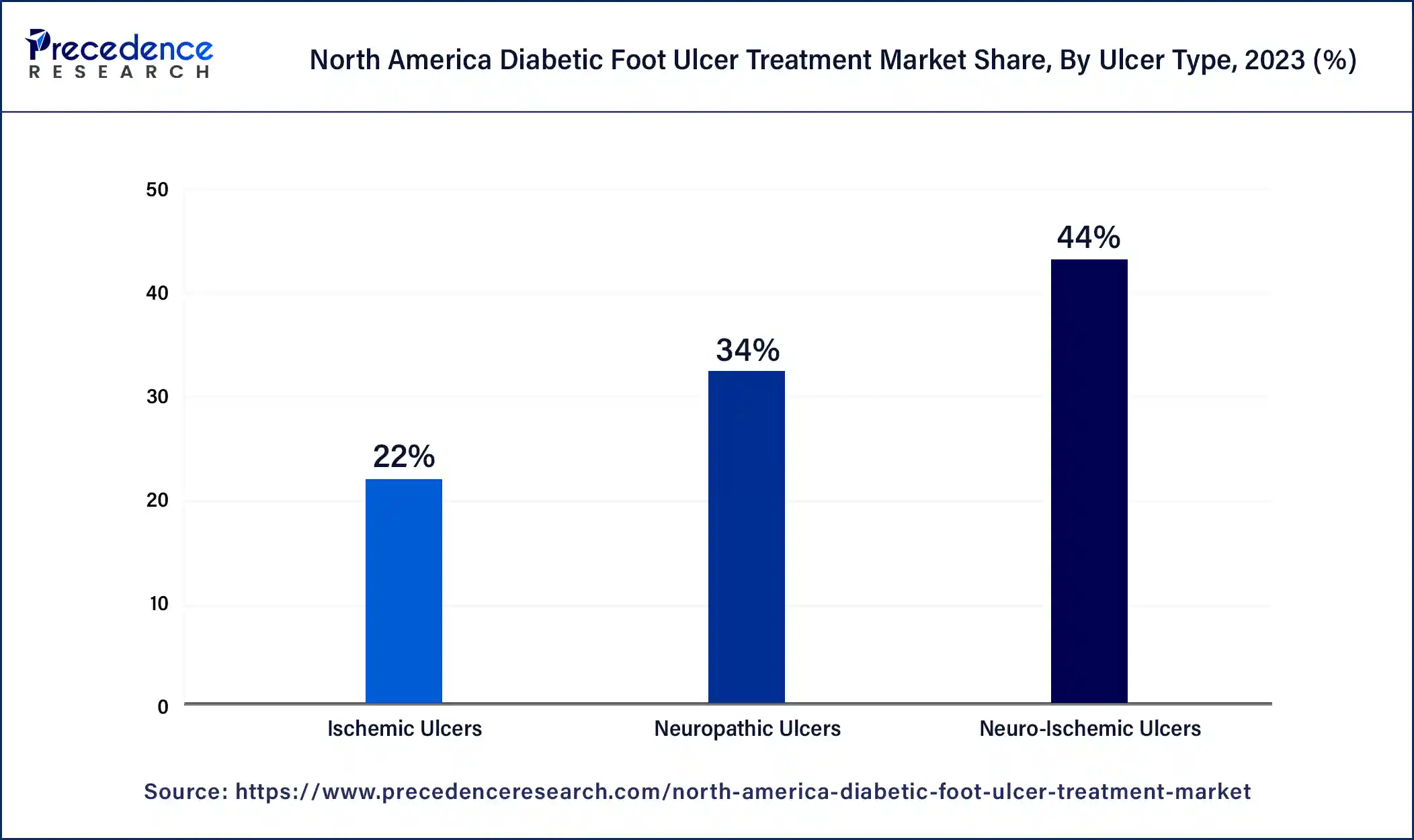
The neuropathic ulcers segment is estimated to grow fastest during the fastest period. Neuropathic ulcers affect the nerves of the feet and legs that carry touch, temperature, and pain messages. They are caused by trauma or pressure that goes undetected due to a lack of sensation around pressure points. Neuropathic ulcers are the most prevalent type of ulcer, affecting up to 50% of diabetic patients during their lifetime. This further drives the market growth.
Treatment Insights
The wound dressing segment dominated North America diabetic foot ulcer treatment market in 2024. Wound dressing is the most common choice for DFU patients. The wound is generally cleaned with saline and a topical gel or antibiotic ointment is applied and wrapped with a clean gauze dressing. Dressings alleviate symptoms, provide wound protection, and encourage healing. They are also cost-effective, hence preferred by a larger population. The different types of dressings include non-adhesive dressings, foam and alginate dressings, hydrogels, inadine and silver dressings, and occlusive dressings. Physicians prescribe the type of dressing depending on the severity of the patient.
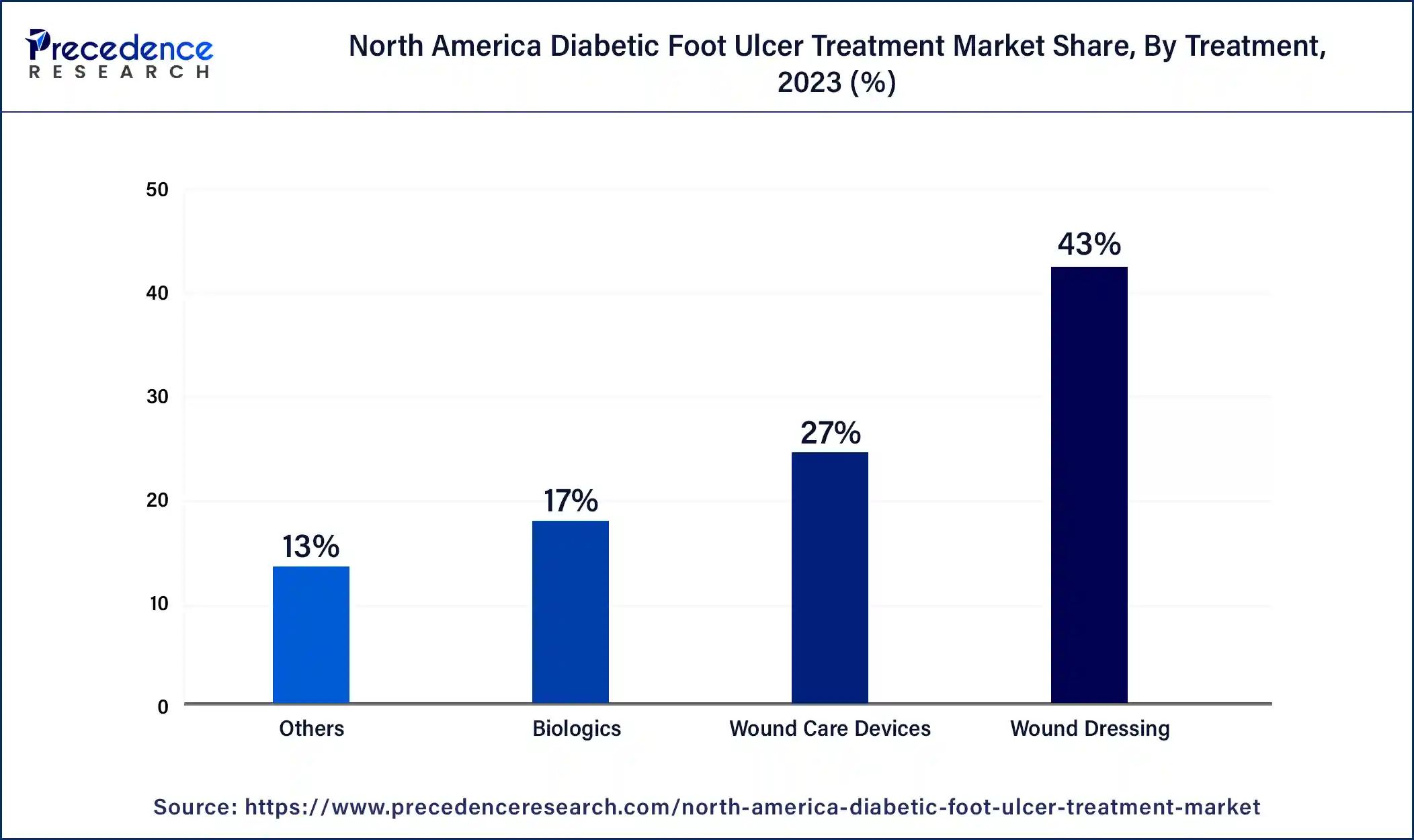
The wound care devices segment is estimated to grow fastest during the forecast period. The devices offer advanced care and relief from the symptoms. The wound care devices include therapeutic footwear, brace, specialized castings, wheelchairs, or walking aids for “off-loading”. WHO has released guidelines for promoting assistive technology and rehabilitation services for people living with diabetes and its related complications. These aspects augment the growth of the market.
End-user Insights
The hospital segment dominated the North America diabetic foot ulcer treatment market in 2024. Hospitals offer a multidisciplinary approach to DFU, integrating the expertise of diabetologists, nutritionists, podiatrists, physiotherapists, etc. Hospitals provide a wide range of services from diagnosis to complete treatment with the availability of special instruments and equipment making it a preferred choice for patients. Additionally, the advancements in surgical instruments encourage patients to prefer hospitals.
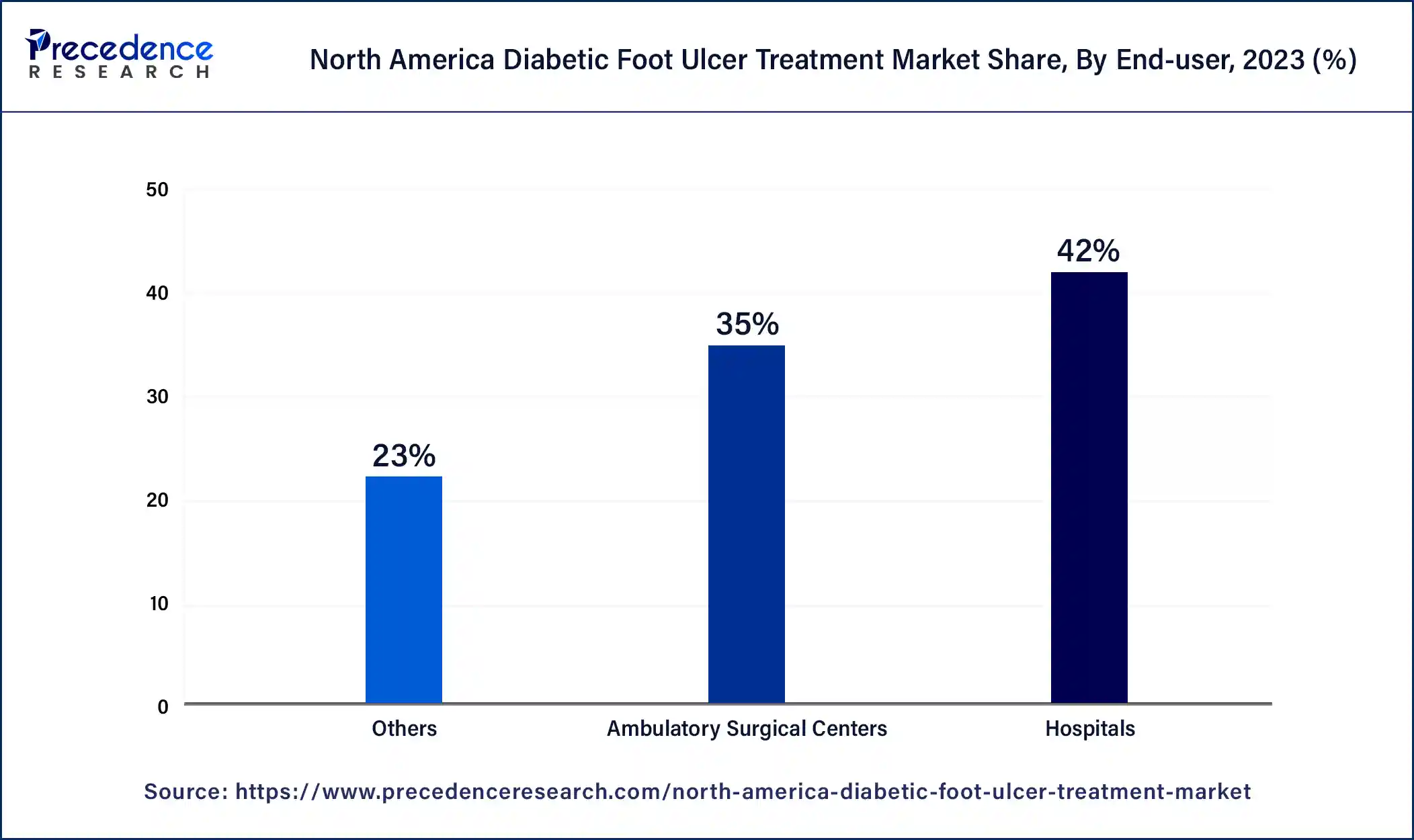
The ambulatory surgical centers segment is estimated to grow fastest during the forecast period. Ambulatory surgical centers (ASC) are modern healthcare facilities specializing in same-day surgical care. They revolutionize the outpatient experience for millions of Americans by offering patients a more convenient option to hospital-based outpatient operations. They offer numerous surgical interventions including pain and podiatry. The lower cost and reduced time of patient admission encourage the use of ASC among individuals.
North America Diabetic Foot Ulcer Treatment Market Companies
- AOTI, Inc.
- Compedica
- 3M Health Care
- Podimetrics
- StimLabs
- Adlore, Inc.
- Syntr Health Technologies
- Spectral AI
- Microbion Corp.
- BioStem Technologies
Recent Developments
- In December 2023, AOTI announced that the Wound Healing Society (WHS) awarded topical oxygen a Level I adjunctive treatment recommendation in its 2023 DFU treatment guidelines. Topical oxygen delivers oxygen topically into chronic wounds and has been shown to increase the incidence of healing and decrease the time to heal.
- In August 2024, Podimetrics announced a collaboration with HTEC, a global product development and engineering services company. The collaboration was made to strengthen Podimetrics' position as a prominent diabetic foot care company by enhancing its platform's detection capabilities, reducing manual intervention, improving patient outcomes, and building a more comprehensive care approach.
Segments Covered in the Report
By Ulcer Type
- Neuro-Ischemic Ulcers
- Neuropathic Ulcers
- Ischemic Ulcers
By Treatment
- Wound Dressing
- Non-adhesive Dressings
- Foam and Alginate Dressings
- Hydrogels
- Inadine and Silver Dressings
- Occlusive Dressings
- Wound Care Devices
- Biologics
- Others
By End-user
- Hospitals
- Ambulatory Surgical Centers
- Others
By Country
- United States
- Canada
For inquiries regarding discounts, bulk purchases, or customization requests, please contact us at sales@precedenceresearch.com
Frequently Asked Questions
Ask For Sample
No cookie-cutter, only authentic analysis – take the 1st step to become a Precedence Research client